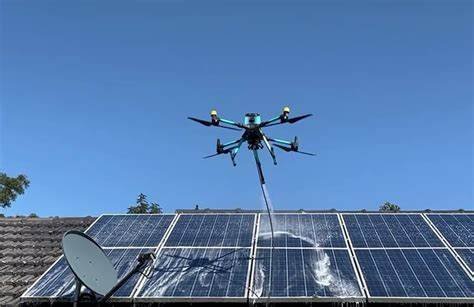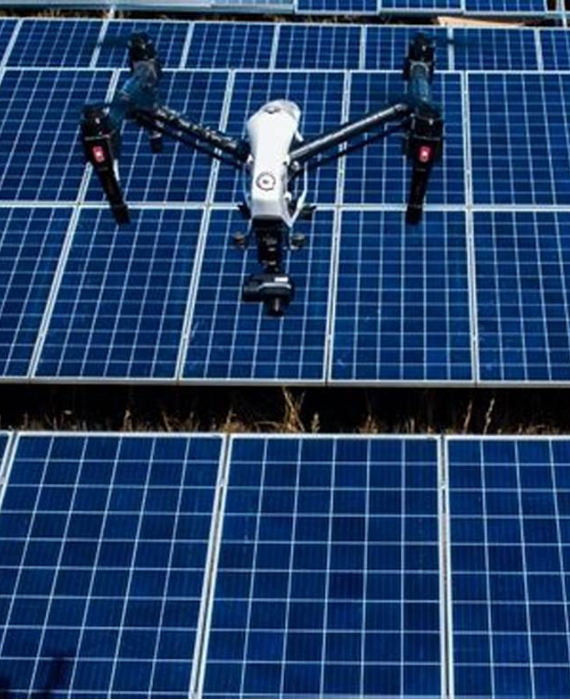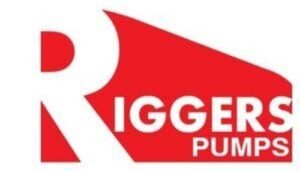High-Pressure Drone Solar Panel Cleaning System
Maximize solar output and ROI with a smarter cleaning approach. Traditional methods—manual labor, scaffolding, or fixed robots—struggle with large-scale arrays, safety concerns, and water usage. Our High-Pressure Drone Solar Panel Cleaning System transforms maintenance into a safe, efficient, and eco-conscious operation.

Why Clean Solar Panels?
Efficiency = Profitability: Even a 2–3% drop in cleanliness reduces power output significantly. Routine cleaning restores optimal performance and accelerates return on investment.
Access Challenges: From rooftop arrays to floating installations, many systems are hard to reach. Drones navigate these areas without risk to technicians or equipment.
Environmental Impact: In dry regions or areas with water restrictions, drones use up to 60% less water compared to traditional methods—no chemical runoff, no compromise.
Manual Labor = Risk: High rooftops and vast arrays increase fall risk and injury potential. Drone automation keeps people safe and reduces crew size.
How High Pressure Washers Work for Blinds & Awnings
Our high pressure washers for blinds and awnings come equipped with adjustable pressure settings, making them suitable for a wide variety of materials, including canvas, vinyl, and metal.
Process Overview:
Site Mapping & AI Planning
Drones scan your array using photogrammetry or LiDAR, identifying soiled zones and mapping optimal cleaning paths.
Autonomous Jet Cleaning
Real-Time Visual Monitoring
Final Inspection & Reporting
Features
Flight Control: GPS precision with obstacle avoidance & fail-safe auto-return
Jet Nozzle: 50–100 bar pressure; 5–8 L/min; safe for panel glass & frames
Quick-Swap Modules: 10L tank (12 min clean), 25-min flight time batteries
Smart Camera: 12MP RGB + optional IR for micro-crack & soiling detection
Adaptive AI: Identifies dirty spots, adjusts spray intensity, and conserves battery
Applications
Utility-Scale Farms
Clean 100-acre arrays without stepping on the field.
Commercial Rooftops
Access tall buildings without disrupting tenants.
Floating Solar
Safe over water—no need for boats or wet crews.
Agrivoltaics
No trampling crops or disturbing livestock.
Distributed C&I Sites
One drone, multiple rooftops = zero setup fuss.
Technical Specifications
These are the main parts that define the performance and reliability of our vehicle washing pumps and machines:
| Component | Brands / Materials | Function |
|---|---|---|
| Motors / Diesel Engines | Crompton Greaves, Marathon, Havells, Kirloskar, Siemens, ABB | Primary power source, available in electric or diesel-driven models. |
| Triplex Pump | Annovi Reverberi, Boutoloni, Hawk, CAT Pump, PFNL | Generates high-pressure water for effective vehicle cleaning. |
| Feed / Auxiliary Pump | OEM / Custom | Maintains steady water flow when the inlet supply is inconsistent. |
| Electrical Panel | Industrial Grade | Provides control and electrical safety for operations. |
| Hydraulic Tubes | Reinforced, high-strength material | Transfers water safely under high pressure. |
| Base Frame | Mild Steel / Heavy-duty Fabrication | Ensures stable, vibration-free system support. |
| Mounting Options | Trolley-mounted, Skid-mounted, Truck-mounted | Flexible setups for garages, fleets, and industrial use. |
Why Choose Us
- Over five years of R&D in autonomous drone cleaning technologies tailored for solar O&M.
- In-house team of engineers specializing in flight-control algorithms, fluid dynamics, and solar asset management.
- We assess your specific panel type (glass, frameless, bifacial) and local environmental conditions (dust load, bird activity) to calibrate pressure settings and nozzle configurations.
- Modular attachments—such as UV-sterilization heads or anti-corrosion spray modules—address unique site requirements.
- On-site operator training covering drone piloting, safety protocols, and regulatory compliance.
- 24/7 remote monitoring, software updates, and preventive-maintenance recommendations ensure uninterrupted operations.
- All drones are DGCA-approved, carry valid PMLA (Permission for Movement of Light Drones) certificates, and meet local CCTV and environmental norms.
- Cleaning solutions comply with CPCB (Central Pollution Control Board) standards and are biodegradable, ensuring zero negative impact on soil and waterways.
- Post-cleaning reports include high-resolution inspection images, panel-level performance indicators, and water usage logs—enabling predictive maintenance and O&M budgeting.
- Integration with SCADA or O&M platforms for seamless data transfer and analytics.

FAQ
Cleaning frequency depends on local soiling rates. In desert or high-pollen regions, monthly or bi-monthly cleaning may be necessary. In cleaner environments, quarterly cleaning often suffices to maintain optimal performance.
We use adjustable pressure settings (50–100 bar) and soft-flow nozzles to match panel manufacturer guidelines. Before the first mission, a test spray verifies safe pressure levels for your specific panels.
On average, our system uses 5–8 L/min per drone. A medium-sized field (1 MW ground-mounted array) typically requires 1,500–2,000 L of water per cleaning—up to 60% less than manual wash methods.
Yes. Our drones adapt flight altitude to panel tilt (up to 35° angles) and maintain stable hover over uneven ground using LiDAR-based altitude hold—ensuring uniform nozzle distance and spray angle.
Onboard ultrasonic wind sensors detect gusts above 12 km/h and automatically pause the cleaning mission. The drone either hovers in place or returns to the ground station if conditions worsen.
